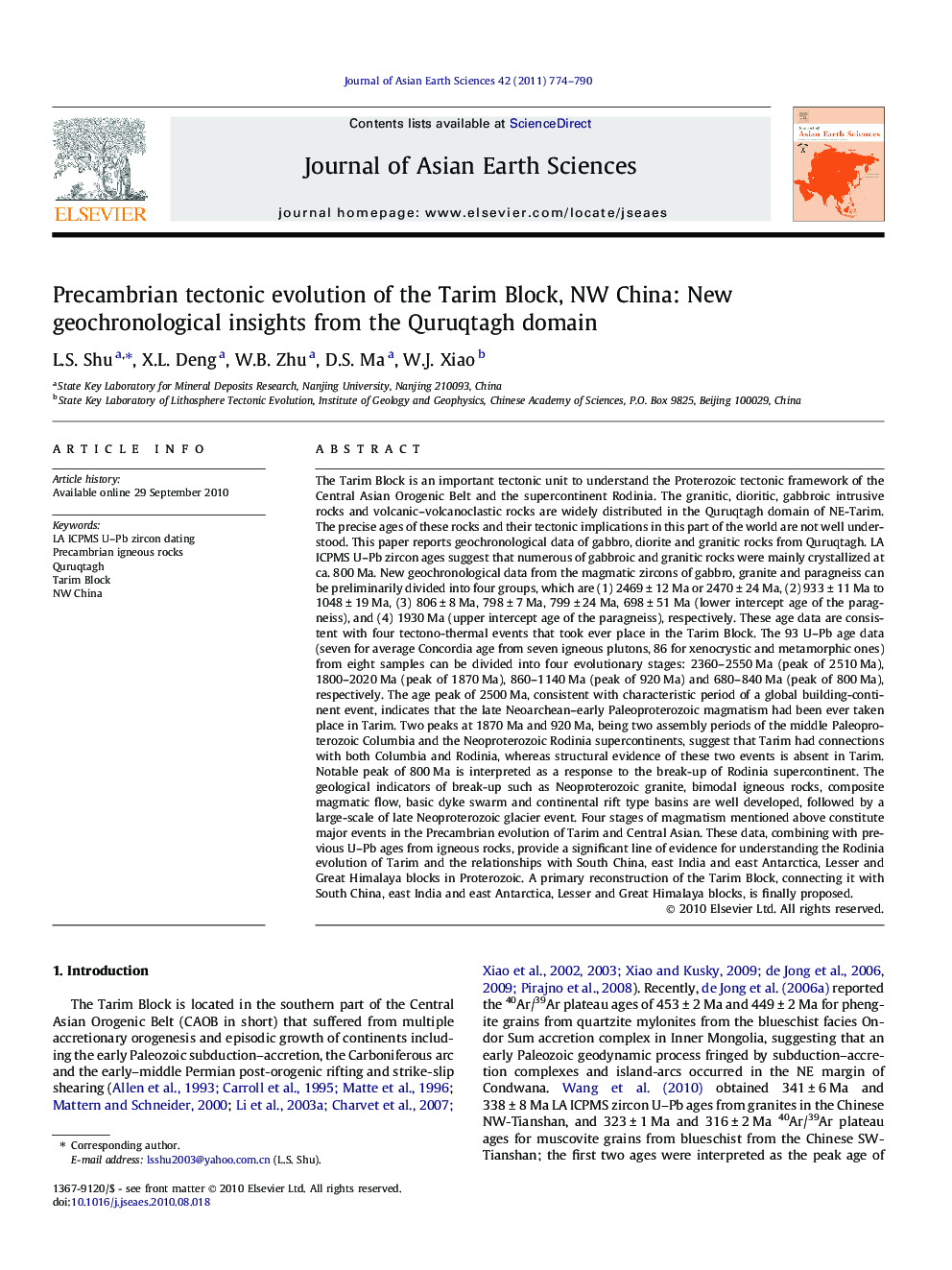| کد مقاله | کد نشریه | سال انتشار | مقاله انگلیسی | نسخه تمام متن |
|---|---|---|---|---|
| 4731713 | 1356818 | 2011 | 17 صفحه PDF | دانلود رایگان |

The Tarim Block is an important tectonic unit to understand the Proterozoic tectonic framework of the Central Asian Orogenic Belt and the supercontinent Rodinia. The granitic, dioritic, gabbroic intrusive rocks and volcanic–volcanoclastic rocks are widely distributed in the Quruqtagh domain of NE-Tarim. The precise ages of these rocks and their tectonic implications in this part of the world are not well understood. This paper reports geochronological data of gabbro, diorite and granitic rocks from Quruqtagh. LA ICPMS U–Pb zircon ages suggest that numerous of gabbroic and granitic rocks were mainly crystallized at ca. 800 Ma. New geochronological data from the magmatic zircons of gabbro, granite and paragneiss can be preliminarily divided into four groups, which are (1) 2469 ± 12 Ma or 2470 ± 24 Ma, (2) 933 ± 11 Ma to 1048 ± 19 Ma, (3) 806 ± 8 Ma, 798 ± 7 Ma, 799 ± 24 Ma, 698 ± 51 Ma (lower intercept age of the paragneiss), and (4) 1930 Ma (upper intercept age of the paragneiss), respectively. These age data are consistent with four tectono-thermal events that took ever place in the Tarim Block. The 93 U–Pb age data (seven for average Concordia age from seven igneous plutons, 86 for xenocrystic and metamorphic ones) from eight samples can be divided into four evolutionary stages: 2360–2550 Ma (peak of 2510 Ma), 1800–2020 Ma (peak of 1870 Ma), 860–1140 Ma (peak of 920 Ma) and 680–840 Ma (peak of 800 Ma), respectively. The age peak of 2500 Ma, consistent with characteristic period of a global building-continent event, indicates that the late Neoarchean–early Paleoproterozoic magmatism had been ever taken place in Tarim. Two peaks at 1870 Ma and 920 Ma, being two assembly periods of the middle Paleoproterozoic Columbia and the Neoproterozoic Rodinia supercontinents, suggest that Tarim had connections with both Columbia and Rodinia, whereas structural evidence of these two events is absent in Tarim. Notable peak of 800 Ma is interpreted as a response to the break-up of Rodinia supercontinent. The geological indicators of break-up such as Neoproterozoic granite, bimodal igneous rocks, composite magmatic flow, basic dyke swarm and continental rift type basins are well developed, followed by a large-scale of late Neoproterozoic glacier event. Four stages of magmatism mentioned above constitute major events in the Precambrian evolution of Tarim and Central Asian. These data, combining with previous U–Pb ages from igneous rocks, provide a significant line of evidence for understanding the Rodinia evolution of Tarim and the relationships with South China, east India and east Antarctica, Lesser and Great Himalaya blocks in Proterozoic. A primary reconstruction of the Tarim Block, connecting it with South China, east India and east Antarctica, Lesser and Great Himalaya blocks, is finally proposed.
Research highlights
► Geochronological data from gabbro, diorite and granitic rocks in the Quruqtagh domain of NE-Tarim are presented.
► Eight samples yielded four groups of zircon U–Pb age: (1) 2469 ± 12 Ma or 2470 ± 24 Ma, (2) 933 ± 11 Ma to 1048 ± 19 Ma, (3) 806 ± 8 Ma, 798 ± 7 Ma, 799 ± 24 Ma, 698 ± 51 Ma, and (4) 1930 Ma, respectively.
► The age data provide new constraints on the continental growth history of Tarim Craton in the interval from early Paleoproterozoic to middle Neoproterozoic, and trace the link with tectonothermal events associated with the assembly and/or breakup of the Proterozoic supercontinents Columbia and Rodinia.
Journal: Journal of Asian Earth Sciences - Volume 42, Issue 5, 10 October 2011, Pages 774–790